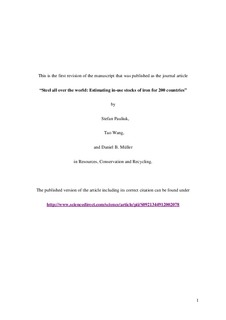| dc.description.abstract | Industrialization and urbanization in the developing world have boosted steel demand during the recent
two decades. Reliable estimates on how much steel is required for high economic development are
necessary to better understand the future challenges for employment, resource management, capacity
planning, and climate change mitigation within the steel sector. During their use phase, steel-containing
products provide service to people, and the size of the in-use stock of steel can serve as an indicator of the
total service level. We apply dynamic material flow analysis to estimate in-use stocks of steel in about
200 countries and identify patterns of how stocks evolve over time. Three different models of the steel
cycle are applied and a full uncertainty analysis is conducted to obtain reliable stock estimates for the
period 1700–2008.
Per capita in-use stocks in countries with a long industrial history, e.g., the U.S, the UK, or Germany,
are between 11 and 16 tons, and stock accumulation is slowing down or has come to a halt. Stocks in
countries that industrialized rather recently, such as South Korea or Portugal, are between 6 and 10 tons
per capita and grow fast. In several countries, per capita in-use stocks of steel have saturated or are close
to saturation. We identify the range of saturation to be 13 ± 2 tons for the total per capita stock, which
includes 10 ± 2 tons for construction, 1.3 ± 0.5 tons for machinery, 1.5 ± 0.7 tons for transportation, and
0.6 ± 0.2 tons for appliances and containers. The time series for the stocks and the saturation levels can
be used to estimate future steel production and scrap supply.
Keywords: Material flow analysis; Steel; In-use stocks; Saturation hypothesis; Materials;
Economic development; | nb_NO |
